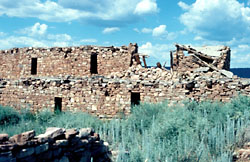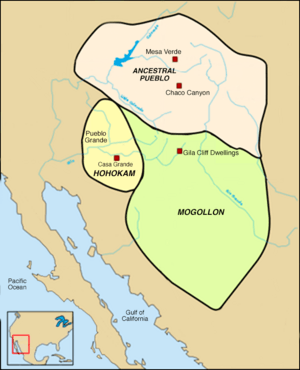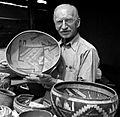Kinishba Ruins facts for kids
|
Kinishba Ruins
|
|

Kinishba Ruins
|
|
| Location | Gila County, Arizona, USA |
|---|---|
| Nearest city | Canyon Day, Arizona |
| Architect | Vernacular |
| Architectural style | Ancestral Pueblo |
| NRHP reference No. | 66000180 |
Quick facts for kids Significant dates |
|
| Added to NRHP | October 15, 1966 |
| Designated NHL | July 19, 1964 |
Kinishba Ruins is an amazing ancient site in eastern Arizona. It was once a huge village with about 600 rooms! This special place was built by people of the Mogollon and Ancestral Puebloan cultures.
Today, the White Mountain Apache Tribe takes care of Kinishba Ruins. It's located on their land, near the community of Canyon Day. Because it shows traits from both Mogollon and Ancestral Puebloan people, experts believe it's connected to the history of the Hopi and Zuni tribes. Kinishba Ruins is so important that it's called a National Historic Landmark.
The ruins sit about 5,000 feet (1,524 meters) above sea level. They are in a beautiful valley surrounded by pine trees. People have known about Kinishba for a very long time, including the Apache people and even early Spanish explorers. The first time it was written about in English was in 1892 by an archaeologist named Adolph Bandelier.
In 1964, the U.S. government officially recognized Kinishba as a National Historic Landmark. The site was cleaned up and partly restored between 2005 and 2007. Some historians think Kinishba might be the village called Chiciticale that was mentioned by the Spanish explorer Francisco Vázquez de Coronado in the 1540s.
Contents
What Does Kinishba Mean?
From 1931 to 1940, a famous archaeologist named Dr. Byron Cummings led a team to dig up and restore Kinishba. He was the head of archaeology at the University of Arizona. Dr. Cummings gave the site its name, ki datbaa. This comes from Apache words that mean "brown house."
About Kinishba Ruins
Where is Kinishba Located?
Kinishba is about 5,000 feet (1,524 meters) high, south of the Mogollon Rim and north of the Salt River. It's at the base of a mountain called Tsé Sizin, or "Rock Standing Up." The ruins are on land belonging to the White Mountain Apache Tribe, within the Fort Apache Indian Reservation.
The site is in a valley that slopes down to the White River. It's easier to reach than many other large ancient villages in the Fort Apache area. Experts believe Kinishba was built and lived in from the 12th to the 14th centuries. This was a time when many people lived in the Mogollon Rim region.
What Was Kinishba Like?
The Kinishba village, also known as a pueblo, has nine main building areas. These are the remains of stone buildings, some of which were three stories tall! There were two large apartment-like buildings and several smaller ones. The village also had two shared courtyards.
At its busiest, Kinishba might have been home to 1,000 to 1,500 people. The walls were built in a special way, with two layers of stone. The rooms were usually about 14 by 12 feet (4.3 by 3.7 meters) and had a fire pit in the middle. Most families likely used two rooms: one for living and one for storing things.
In the smaller courtyard, there was a kiva. A kiva is a special underground room used for religious ceremonies. The larger courtyard showed signs of three different stages of ceremonies. It was 63 by 51 feet (19.2 by 15.5 meters) in size.
How Was Kinishba Built and Used?
The largest villages from the 13th and 14th centuries in the Mogollon Rim area share many things. They all have similar building styles and types of pottery. They were also built near good land for growing corn without much water. These villages also had easy access to water, stone for building, and ponderosa pine trees.
All these big villages were made of apartment-style buildings. These buildings were arranged to create shared courtyards or open spaces.
The people living at Kinishba grew corn, beans, and gourds nearby. They planted these crops together to save water. They might have also grown cotton. They gathered fruits, berries, nuts, and other foods from the local area. The White Mountains region provided plenty of resources for hunting and gathering food. Women would prepare meat for eating and use animal skins, tendons, and bones for clothing, tools, and other needs.
Kinishba and other nearby villages were left by the Mogollon people in the late 14th or early 15th century. No one knows exactly why they left. It might have been because a water source dried up. After they left, the area was mostly empty until the Apache people arrived from the western Great Plains. The Apache did not use the ruins themselves.
Archaeological Digs at Kinishba
Over many years, people looking for treasures and soldiers from Fort Apache looking for souvenirs damaged the site. In 1892, Adolph Bandelier, an early archaeologist, was the first European to write about Kinishba. Other archaeologists visited after him.
From 1931 into the 1940s, Byron Cummings from the University of Arizona led a team. This team included university students and 10 to 27 White Mountain Apache workers. They worked together to dig up and restore the site. Cummings named the site ki datbaa, which means "brown house" in the Apache language.
Dr. Cummings created a special "field school" at the site for his university students. This school ran from 1931 to 1939. He found different ways to pay for the workers and materials, including help from the Civilian Conservation Corps and the Bureau of Indian Affairs. Some Apache men, like Chester Holden, David Kane, and Turner Thompson, worked at the site for many years and cared deeply about its preservation.
In 1939, the teams also built a small museum and tourist spot. This museum was meant to hold artifacts found at the site and help people learn about it. It was also built during the Great Depression to help the Apache people sell their crafts and have steady jobs. Cummings was very good at combining research, training, working with different tribes, preserving history, and developing tourism. This was one of the first projects of its kind in Arizona. His teams dug up at least 220 rooms and rebuilt about 140. He helped create what we now call a heritage tourism destination.
Cummings believed the site was so important that it should become a National Monument. He wanted the National Park Service to manage it. However, the Park Service preferred sites that were easier to reach, especially during the Great Depression and World War II. So, Cummings didn't succeed in having the National Park Service take over.
In 1956, the Department of the Interior published a booklet about the "Kinishba Ruins and Museum." In 1964, the site was officially named a National Historic Landmark and added to the National Register of Historic Places.
Since then, the ruins haven't been fully maintained and have started to fall apart, just like the museum. A partial restoration was done from 2005 to 2007 to help stabilize the site. The White Mountain Apache Tribe and the Fort Apache Heritage Foundation now manage Kinishba. It's part of the Fort Apache Historic Park. Visitors need to get a permit from the White Mountain Apache Tribe to visit Kinishba Ruins.
The White Mountain Apache have also built their own museum at the Fort Apache Historic Park. It's designed like a traditional Apache home, called a gowa. The museum is called Nohwike' Bágowa, or "House of Our Footprints." The park also includes a 288-acre (117 ha) National Historic District with 27 buildings from when the U.S. Army used the fort. The reservation has buildings from ancient times to today. The tribe shares the history of the Mogollon Rim Pueblo people, as well as the history of the White Mountain Apache.
Images for kids
-
A large Kinishba bowl held by Prof. Byron Cummings, who excavated the ruins in the 1930s. Photo shows other pottery collected by Cummings at Kinishba or nearby. Circa 1940s photo by Arizona State Museum.






